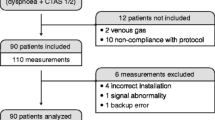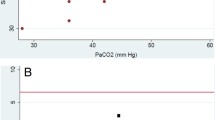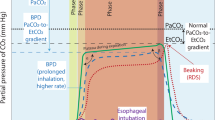Abstract
Hyper or hypoventilation may have serious clinical consequences in critically ill patients and should be generally avoided, especially in neurosurgical patients. Therefore, monitoring of carbon dioxide partial pressure by intermittent arterial blood gas analysis (PaCO2) has become standard in intensive care units (ICUs). However, several additional methods are available to determine PCO2 including end-tidal (PetCO2) and transcutaneous (PtcCO2) measurements. The aim of this study was to compare the accuracy and reliability of different methods to determine PCO2 in mechanically ventilated patients on ICU. After approval of the local ethics committee PCO2 was determined in n = 32 ICU consecutive patients requiring mechanical ventilation: (1) arterial PaCO2 blood gas analysis with Radiometer ABL 625 (ABL; gold standard), (2) arterial PaCO2 analysis with Immediate Response Mobile Analyzer (IRMA), (3) end-tidal PetCO2 by a Propaq 106 EL monitor and (4) transcutaneous PtcCO2 determination by a Tina TCM4. Bland–Altman method was used for statistical analysis; p < 0.05 was considered statistically significant. Statistical analysis revealed good correlation between PaCO2 by IRMA and ABL (R2 = 0.766; p < 0.01) as well as between PtcCO2 and ABL (R2 = 0.619; p < 0.01), whereas correlation between PetCO2 and ABL was weaker (R2 = 0.405; p < 0.01). Bland–Altman analysis revealed a bias and precision of 2.0 ± 3.7 mmHg for the IRMA, 2.2 ± 5.7 mmHg for transcutaneous, and −5.5 ± 5.6 mmHg for end-tidal measurement. Arterial CO2 partial pressure by IRMA (PaCO2) and PtcCO2 provided greater accuracy compared to the reference measurement (ABL) than the end-tidal CO2 measurements in critically ill in mechanically ventilated patients patients.



Similar content being viewed by others
References
Curley G, Laffey JG, Kavanagh BP. Bench-to-bedside review: carbon dioxide. Crit Care. 2010;14(2):220. doi:10.1186/cc8926.
Georgiou AP, Gouldson S, Amphlett AM. The use of capnography and the availability of airway equipment on intensive care units in the UK and the Republic of Ireland. Anaesthesia. 2010;65(5):462–7. doi:10.1111/j.1365-2044.2010.06308.x.
Husain T, Gatward JJ, Hambidge OR, Asogan M, Southwood TJ. Strategies to prevent airway complications: a survey of adult intensive care units in Australia and New Zealand. Br J Anaesth. 2012;108(5):800–6. doi:10.1093/bja/aes030.
Kannan S, Manji M. Survey of use of end-tidal carbon dioxide for confirming tracheal tube placement in intensive care units in the UK. Anaesthesia. 2003;58(5):476–9.
Janssens JP, Howarth-Frey C, Chevrolet JC, Abajo B, Rochat T. Transcutaneous PCO2 to monitor noninvasive mechanical ventilation in adults: assessment of a new transcutaneous PCO2 device. Chest. 1998;113(3):768–73.
Fowler RA, Berenson M. Blood conservation in the intensive care unit. Crit Care Med. 2003;31(12 Suppl):S715–20. doi:10.1097/01.CCM.0000099350.50651.46.
Vincent JL, Baron JF, Reinhart K, Gattinoni L, Thijs L, Webb A, Meier-Hellmann A, Nollet G, Peres-Bota D, Investigators ABC. Anemia and blood transfusion in critically ill patients. JAMA J Am Med Assoc. 2002;288(12):1499–507.
Belenkiy S, Ivey KM, Batchinsky AI, Langer T, Necsoiu C, Baker W, Salinas J, Cancio LC. Noninvasive carbon dioxide monitoring in a porcine model of acute lung injury due to smoke inhalation and burns. Shock. 2013;39(6):495–500. doi:10.1097/SHK.0b013e318292c331.
Shoemaker WC, Wo CC, Yu S, Farjam F, Thangathurai D. Invasive and noninvasive haemodynamic monitoring of acutely ill sepsis and septic shock patients in the emergency department. Eur J Emerg Med. 2000;7(3):169–75.
Tatevossian RG, Wo CC, Velmahos GC, Demetriades D, Shoemaker WC. Transcutaneous oxygen and CO2 as early warning of tissue hypoxia and hemodynamic shock in critically ill emergency patients. Crit Care Med. 2000;28(7):2248–53.
Hinkelbein J, Floss F, Denz C, Krieter H. Accuracy and precision of three different methods to determine PCO2 (Paco2 vs. Petco2 vs. Ptcco2) during interhospital ground transport of critically ill and ventilated adults. J Trauma. 2008;65(1):10–8. doi:10.1097/TA.0b013e31815eba83.
Bland JM, Altman DG. Statistical methods for assessing agreement between two methods of clinical measurement. Lancet. 1986;1(8476):307–10.
Prause G, Ratzenhofer-Komenda B, Offner A, Lauda P, Voit H, Pojer H. Prehospital point of care testing of blood gases and electrolytes—an evaluation of IRMA. Crit Care. 1997;1(2):79–83. doi:10.1186/cc108.
Wahr JA, Lau W, Tremper KK, Hallock L, Smith K. Accuracy and precision of a new, portable, handheld blood gas analyzer, the IRMA. J Clin Monit. 1996;12(4):317–24.
Janssens JP, Laszlo A, Uldry C, Titelion V, Picaud C, Michel JP. Non-invasive (transcutaneous) monitoring of PCO2 (TcPCO2) in older adults. Gerontology. 2005;51(3):174–8. doi:10.1159/000083990.
Janssens JP, Perrin E, Bennani I, de Muralt B, Titelion V, Picaud C. Is continuous transcutaneous monitoring of PCO2 (TcPCO2) over 8 h reliable in adults? Respir Med. 2001;95(5):331–5. doi:10.1053/rmed.2001.1045.
Russell GB, Graybeal JM. End-tidal carbon dioxide as an indicator of arterial carbon dioxide in neurointensive care patients. J Neurosurg Anesthesiol. 1992;4(4):245–9.
Christensen MA, Bloom J, Sutton KR. Comparing arterial and end-tidal carbon dioxide values in hyperventilated neurosurgical patients. Am J Crit Care. 1995;4(2):116–21.
Seguin P, Bleichner JP, Branger B, Guillou YM, Feuillu A, Malledant Y. The measurement of end-tidal carbon dioxide (PETCO2) is not a significant parameter to monitor in patients with severe traumatic brain injury. Can J Anaesth. 2001;48(4):396–400.
Barton C, Callaham M. Lack of correlation between end-tidal carbon dioxide concentrations and Paco2 in cardiac arrest. Crit Care Med. 1991;19(1):108–10.
Acknowledgments
This work was supported by intradepartmental funds only. No external financial support was obtained. The Immediate Response Mobile Analyzer (IRMA) and the Tina TCM4 were provided by Keller Medical (Bad Soden, Germany) and Radiometer (Copenhagen, Denmark) solely for the duration of the study.
Author information
Authors and Affiliations
Corresponding author
Ethics declarations
Conflict of interest
The authors have no conflicts of interest to declare.
Rights and permissions
About this article
Cite this article
Spelten, O., Fiedler, F., Schier, R. et al. Transcutaneous PtcCO2 measurement in combination with arterial blood gas analysis provides superior accuracy and reliability in ICU patients. J Clin Monit Comput 31, 153–158 (2017). https://doi.org/10.1007/s10877-015-9810-8
Received:
Accepted:
Published:
Issue Date:
DOI: https://doi.org/10.1007/s10877-015-9810-8




